Neighbors helping neighbors
From the beginning, we wanted to create an environment that would offer senior living residents a sense of community and peace to help them feel free and fully engage in the joys of living. Today, our residents in Lynchburg, VA, live that vision in their own way, sharing their personal stories and enhancing the experience for all of us here now.
To support their active role in this community, we hold monthly town meetings with the Resident Council, its committees, and a community staff team member. This level of clarity in communication is important to our goal of ensuring an engaging living environment.
The Summit Benevolent Fund
Critical to our vision is the commitment that no resident will be asked to leave The Summit for financial reasons beyond their control. The Summit Benevolent Fund was formed to provide the financial support needed, should a resident exhaust their resources through no fault of their own. We believe this exemplifies community in its truest sense.
Let’s meet some of your neighbors.
Mike and Sandy Walker accumulated a house of full of things over 21 years. When it was time to move to The Summit, downsizing was inevitable—and as it turns out—energizing.

“While we were looking at the things we had, I would look and think, ‘why did I get this to begin with?’ Part of it was letting go of some things that we didn’t need,” Sandy said. “It’s a nice feeling to not have to worry about the things you don’t need.”
While decluttering, the Walkers gave important items to their children and donated to Habitat for Humanity and Goodwill.
Sandy, a retired school teacher and counselor, met with Brenda Dixon, Marketing Director of The Summit, and got a floor plan marked with one foot grids. Mike and Sandy measured the furniture they wanted to take out to know exactly what would fit.
Downsizing can be daunting, so start small. “I would say anyone that’s considering making a move, the first thing is to start looking at what’s in your closet and cabinets and think, ‘Do you really need this?’” Sandy said.
The couple picked out wall paper, window treatments and other extras for the apartment before moving in August 15.
“People in general do not like change. It’s hard, but there are some fun parts to it. You can make some changes that you didn’t have in your former house. It was a good move for us.”
The couple joined the Advantage Club in 2018, allowing them to meet residents and experience the community before deciding to move.
“The people here are friendly. The team is just outstanding. We got a glimpse of that before we moved in and we totally saw it when we moved in.”
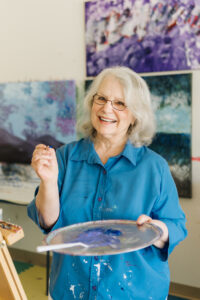 Contemporary Artist and Resident of The Summit Donates All Proceeds to Help War Victims
Contemporary Artist and Resident of The Summit Donates All Proceeds to Help War Victims
Lynchburg, VA: Local artist, Carolyn Avalos, recently announced that 100% of the proceeds from the sale of her work online will go to benefit the victims of the war in Ukraine. The proceeds of all her online sales will go to support Don Shire Ministries (DSM), which supports vulnerable women and children all over the world.
DSM has contacts on both sides of the Ukraine/Poland border helping refugees fleeing the war. They are provided food, shelter, transportation, a Bible, and Christian love. One hundred percent of designated gifts to refugee relief will go to Poland or the Ukraine to help refugees.
 Avalos is passionate about using her talents to help people in need and has partnered with DSM to respond to the critical need in Ukraine. She will culminate her sales online throughout the year with an art show event in her home studio at The Summit in Lynchburg, Va., on December 3, 2022. More details of the event will be available on her social media sites and on her website.
Avalos is passionate about using her talents to help people in need and has partnered with DSM to respond to the critical need in Ukraine. She will culminate her sales online throughout the year with an art show event in her home studio at The Summit in Lynchburg, Va., on December 3, 2022. More details of the event will be available on her social media sites and on her website.
Specializing in abstracts, landscapes and contemporary figurative art, Avalos used funds raised from her work to support charities in the past. In 2021, she hosted an event at her home in Bedford, Va., and sold nearly 50 paintings in one day to benefit the Butterfly Field Farm Sanctuary.
Avalos’ work can be found online on her website: www.CarolynAvalos.com.
DSM is an inter-denominational ministry, governed by a board of directors. All donations to DSM are tax-deductible. More information about Don Shire Ministries can be found at www.donshireministries.org.
May 5, 2020
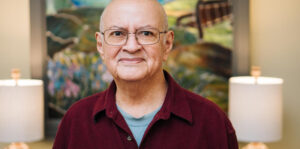 Joe Chavez knows the value of time well spent, finding it in retirement at The Summit.
Joe Chavez knows the value of time well spent, finding it in retirement at The Summit.
No lawn care, no cleaning, no cooking dinner. “They take over your environment 100 percent for you,” Joe said. “Now, you find yourself with time to indulge in your pleasures—walking in the woods, physical activities, games, reading and meditation.”
An avid outdoorsman, Joe keeps up a daily routine of exercise. “That’s very important. If I take a couple of days off because I’m going on a trip, I find my body misses it.”
Joe considers raising children that are caring and giving is his greatest accomplishment. He enjoys sitting with friends at dinner and often meets with fellow members of the Natural Bridge Appalachian Trail Club.
“You sit at different tables at night for dinner, so you meet people from all walks of life,” he said. “You get to know people will similar interests.”
The Summit staff is gracious and accommodating. “They’re not familiar with the word, ‘no.’ They just do everything for you.”
August 1, 2019
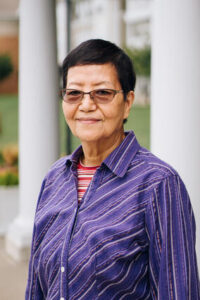
Linda Patch looks forward to her rose bush blooming each June. Keeping a small garden at The Summit is one of her favorite hobbies. She plants tomatoes and cucumbers too, but the rose bush is her favorite. “It’s a really pretty color.”
She moved into the Life Plan Community six years ago. “The people that work here are all so friendly and nice. I’m so happy to live here.”
Linda stays in shape walking around campus. She also enjoys art and exercise activities.
Each month, she joins other residents for Dine-Out Club, trying out local restaurants. “We’re happy here,” Linda said. “It’s a very friendly place to live.”
She looked at other retirement communities before settling on The Summit. “This is my family. It’s like a sweet home. I’m so satisfied.”
March 1, 2019
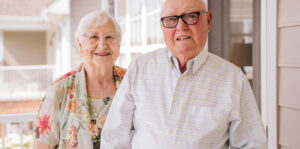
A busy and active life led Mashall and Jean Crews to a relaxed retirement at The Summit.
“I like the idea that we don’t have to do anything,” Jean said. “We can do what we want to do when we want to.”
A retired banker, Marshall spends time gardening, fishing, visiting friends and walking their dog, Buff, who will sing along if you whistle. “We just thought this was the place for us,” Marshall said.
Jean, who taught school for 25 years and worked in an accounting office, loves to knit, crochet, quilt, sew and read.
“I’ve done a lot of different jobs and all of them were enjoyable. That all led to a life that is relaxed here now.”
Married almost 58 years, the couple has three children and eight grandchildren. The Summit is the ideal for them. “I think it’s the most wonderful place. It’s something to do all the time. You just can’t do it all,” Marshall said.
March 1, 2019
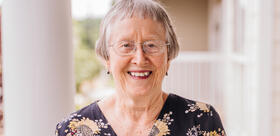
Ice cream dates led Frances Unruh to The Summit. Frances and her husband often frequented an ice cream parlor and looked at the Life Plan Community across the street.
“I would come get ice cream and fantasize what life would be like at The Summit.” Frances made her case for at The Summit. “I told my husband, ‘you’ve been retired 20 years. When do I get to retire?’”
Frances, whose husband died peacefully at their apartment a year later, loves reading, enjoying friends and traveling. “I felt at home from the minute we came in. The people have been wonderful,” she said. “You definitely stay more engaged when you live here.”
She also volunteers with Meals on Wheels. “I think it’s a great program and I enjoy seeing the clients.”
Her advice for moving to The Summit: “Don’t wait too long. Come and enjoy it while you are able.”
December 12, 2018
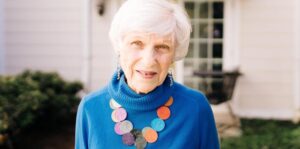
Lila Rosenthal grew up poor and happy. Her father, a Russian immigrant, made sure his kids never knew money was tight.
“We didn’t know because there was so much love in the house,” Lila said. “My dad was so great at covering up what we didn’t have with stuff that we were so grateful to have.”
The New Jersey family took frequent trips to New York City to see skyscrapers, take in a free circus or ride in one of the first cars across the George Washington Bridge. “I had a blessed childhood,” she said. “My father’s family came to Ellis Island with nothing, but love.”
Just before starting college, Lila met her future husband, Macey, who was dating her sister while at Sweet Briar College.
She got to know his mom years before him. When he proposed, she said, “We’ll get married because I love your mother.”
Lila taught school and hosted a television show on WSET. She also raised four wonderful children and has one granddaughter. “I could not be happier. I didn’t deserve all this good stuff.”
April 20, 2017
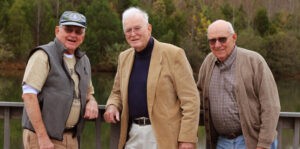
Residents of The Summit checked a big item off their wish list with the extension of the lake trail this summer. The over one-mile trail allows residents to enjoy the sights and sounds of the 8.5-acre lake, a gem of the 143-acre campus.
“I think everyone likes to get out on the trail and so some walking,” Bill Hodges, one of three leaders of the project, said.
Hodges, a long-time resident, said the trail came to fruition after Wayne Greenlaw and Leonard Johnson, both members of the Appalachian Trail Club, moved to The Summit. “We finally had somebody that knew something about trails,” Hodges said with a laugh.
Sixteen members of the Natural Bridge Trail Club teamed with residents and staff to clean out brush along the trail and lay mulch. The trail is eight-feet wide so residents can drive a golf cart around the lake.
“People are going down to the lake on a regular basis. It’s really getting used, which is why it’s here,” Leonard Johnson said. “The mulch makes for a great surface to walk on.”
The Summit is home to many nature enthusiasts, selecting the Life Plan Community because of its natural beauty. Residents regularly spot deer, geese, ducks, a gray heron, a white egret, wild turkeys, rabbits and beavers.
There are plenty of opportunities for bird watching and many enjoy fishing, with large- and small-mouth bass, perch and bluegill stocked in the lake.
“Residents of The Summit love nature and enjoy the serenity of this campus,” Gina Meadows, RN, executive director, said. “Adding this wonderful walking trail makes taking in all of that beauty much easier. We are grateful to Bill, Leonard, Wayne and the other volunteers for making this project a reality.”
During warm weather, the lake trail is a popular spot. Greenlaw built three benches out of leftover wood, providing several spots to sit and enjoy the landscape. The team worked hard to build the trail, which includes an array of wildflowers, around trees instead of taking them down.
The men had a blast working on the project together. “These guys were so enthusiastic,” Greenlaw said. “It was a pleasure to be out working with them.”
February 9, 2017
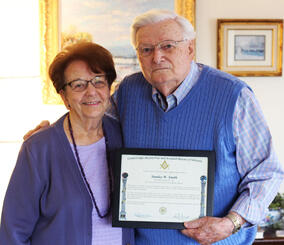
Stan Smith was recently honored for his 60-year commitment to the Grand Masonic Lodge of Nebraska. Stan, who joined the Masons in Omaha, Neb. at 24, said the lodge gave him an opportunity to fellowship and serve with friends.His father was a long-term Mason and his mother was active in Eastern Star, the female equivalent of the Masons. “I wanted to participate with friends that I had made,” Stan said.
As his 60-year anniversary approached, the Grandmaster of Nebraska reached out to the Grandmaster of Virginia to arrange a special ceremony. A deputy grandmaster in Lynchburg presented a plaque to Stan in front of his wife, Lucy, and friends at The Summit in January. “I’m very proud of being a Mason. My father enjoyed it immensely and was proud of being a Mason. I saw it as a continuation of his life and heritage,” Stan said.
Stan began his career in Nebraska as an electrical engineer for Northwestern Bell Telephone Company, before moving into management. He later joined AT&T in New York City to handle logistics. After retiring from AT&T, Stan joined the U.S. Postal Service as an assistant postmaster general, leading a construction budget of $1.5 billion during his five-year tenure. The couple moved to Smith Mountain Lake for a closer commute to Washington, D.C. after Hurricane Hugo damaged their Charleston, S.C. home. “The water at Smith Mountain Lake is very pure,” Stan said. “It’s a wonderful place for recreation.”
They chose to downsize, moving to The Summit for less maintenance and the time freedom to pursue other interests. Stan enjoys genealogy work and leads The Summit Residents Council. Lucy is chair of the Welcoming Committee, answering questions for new residents and serving as an ambassador for potential residents. “It’s a very important job in really making new residents feel welcome to our beautiful community,” Stan said. Stan was an active leader on various boards at Smith Mountain Lake, leading efforts to keep the shoreline clean. Leading the residents council is a natural fit. “The interface between the residents and the administration is very important and you need to formalize a way to do that,” Stan said.
The couple, which moved into The Summit in 2014, love the pace of life on the scenic campus. Their daughter lives in Lynchburg and joins them for lunch once a week. The couple has two daughters and five grandchildren. Stan is among a handful of Masons that call The Summit home. They meet regularly for lunch with members of other lodges. “It’s not a formal meeting as Masons meet, but it’s a good chance to stay involved with what the Masons are doing locally,” Stan said.
November 4, 2016
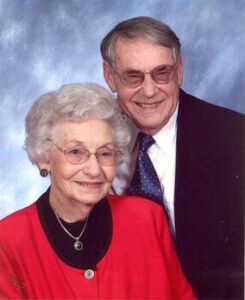
One hundred years ago, Summit citizen Paul Kavanaugh was born November 7th, 1916, on a small farm near Woodstock, Virginia. He was born at home with his grandmother attending his mom. She named her baby Paul after a friend in Harrisonburg, Judge John Paul.
The Kavnaugh home had no in-door plumbing, no electricity, and the family transportation was a horse and buggy. Their lights were kerosene lamps and lanterns. On their 10 acre farm, they grew most of their food in a large garden and on fruit trees of all kinds. They usually had a horse, 2 cows, a couple pigs, and 50 or so chickens. The cows provided milk for the family, and at times, they would have enough milk to sell some to neighbors. Everyone in the family helped care for the cows. The chickens provided eggs for the family and enough to sell when they had extras. Most years, new chickens would be hatched from eggs and raised to replace the older ones.
World War I began in 1918, and it affected most American families. The Kavanaughs were industrious and self-supporting and did not feel effects of the war as much as most people because they grew most of their groceries and the family planned and saved for the winter months. In fact, they purchased their first car, a model “A” ford.
The winters in Woodstock, Virginia, were very cold. The Kavanaugh home had a large wood stove in the kitchen and a coal stove in the living room. There was no heat in the second level of the house, but a ventilator over the stove provided some warm air to the second floor. For wood required in their kitchen stove, Paul’s father would cut trees on their property with a cross-cut saw. These saws are about 6 feet long with a handle on each end. A person would then man each end and pull it back and forth to cut timber. The tree lengths were then hauled on a wagon to their yard. A neighbor would bring in a larger gasoline-powered saw and saw the wood into usable lengths for the kitchen stove. For kindling wood, Paul remembers walking through the woods with his father looking for pine knots for kindling. These are joints of pine which are the portion of the tree where limbs joined the tree trunk. These knots are especially flammable and have been used for fuel wherever wood stoves are used.
The family had a large garden and raised many vegetables. They ate the vegetables fresh from the garden. In the summer, Paul’s mother canned vegetables, jams, jellies, and fruits for them to eat in the winter. A three-foot pit was prepared to use as a root cellar for preservation of vegetables such as turnips and carrots.
For water, the family relied on rain rolling off of their home’s tin roof into a cistern which was about eight feet into the ground. They allowed the water to come off the roof to the ground to clean the major dirt and then divert the water into the cistern. Then, as the water was needed, a wheel on a chain was rolled which brought up water in buckets. A grape arbor was over top of the cistern which provided shade that helped keep the water cool. A cistern was also used at the barn to collect enough water to feed the farm animals.
The fall was time to butcher pigs. Paul’s mother canned the pork and made sausage. Other meat was salted or smoked in preparation to last through the winter. The large cuts of meat such as hams, shoulders, and sides would be hung from the ceiling of the smoke house. A fire would be made in a pit below the meats and smoked for several days.
Paul’s school was a building with a room for each grade. The school had no indoor plumbing, but an outside privy complete with plenty of Sears and Roebuck Catalogs available for toilet paper. Each day the classes had a recess time, and the most favorite game was “Prisoner’s Base,” a running game in which each student would get exercise. When lunch time arrived, the students would eat from their bags brought from home. Many of their lunches were peanut butter and jelly sandwiches along with fruits and maybe, a thermos of milk. The school carried all grades in the same building. While in high school, Paul was a guitarist in a local string band that played for events throughout the Woodstock area. He graduated in 1928 in a senior class of 40 students.
Paul was the third child with a brother 12 years older named Minor and a sister 9 years older named Evva Irene. As a young child, Paul was often cared for by Evva. She became his second mother.
While Paul was growing up, his brother, Minor, was attending the Medical College of Virginia and graduated as a pharmacist about 1922. Minor was able to work at a drug store in Waverly, Virginia, for about 8 years. In 1930 he went to Middleton, Virginia, where he met his wife, and they eventually moved to Arlington, Virginia to open his own drug store. When Paul graduated from high school, he went to live with Minor and Mildred to work in his store. Minor influenced Paul’s life in many ways. Minor began to discuss Paul’s future with him asking what Paul had in mind. When Paul indicated that he felt very strong working with numbers, Minor suggested that he consider going to Benjamin Franklin University to study accounting.
Paul entered Benjamin Franklin University in 1937 and continued working at Minor’s Pharmacy at the same time. After he graduated from Ben Franklin in 1940, he worked at People’s Drug until he was inducted into the Army in August 194l.
Paul’s military life began with training at Ft. Lee, Virginia. After boot camp, he rode a troop train to San Angelo Air Field, Texas, where he was assigned as a dispatcher to coordinate the training for students being trained to fly a BT13 plane. After 3 years, Paul had received promotions to Staff Sergeant. He was then sent to Shawnee, Oklahoma, where he helped students get settled and attend classes at Oklahoma Baptist University.
During Paul’s Oklahoma assignment, he met the love of his life Willie Mae Erwin on a blind date. Willie Mae’s coworkers arranged the date. Paul was very interested in this lovely girl and would see her as often as possible. However, that was difficult since neither of them had a car, and on most of their dates they relied on public transportation. Willie Mae was a legal stenographer for local attorneys.
After another year or so, Paul was transferred to Waco Air Base, Waco, Texas, where he was assigned to the personnel portion of the Headquarters Office. He continued to keep in touch with Willie Mae, and they soon started discussing wedding plans. Willie Mae and a girlfriend rode the bus to Dallas, Texas, where she and Paul got married in a Christian Church near Dallas. One of Paul’s buddies was Paul’s best man, and Willie Mae’s friend became her Maid of Honor.
Paul’s military life continued through assignments to Denver, Colorado, Sioux Fall, South Dakota, and lastly to Greenville, South Carolina. At each of these cities, Willie Mae was immediately hired as a stenographer.
Paul left military life in Greenville, S.C., and they decided to return to Arlington, Virginia, where his brother and his sister lived. As they became settled in their civilian home, they attended a Christian church. A friend at the church remembered Paul and knew that Paul had accounting experience. The friend told Paul, “We need you at the Internal Revenue Service (IRS).”
Paul’s first position at the IRS was in the “Offer and Compromise Section” in which he would discuss problems with IRS clients. In most cases, he looked at the client’s future and their resources and then would offer them a settlement. Most people accepted the decision because that was logically their only way out of the problem.
In 1947 Paul was assigned to IRS Agent School. These classes formalized his knowledge of IRS codes and compliance procedures. The classes lasted about 6 months. Paul and Willie Mae’s first child Pamela was born during Agent School on December 15, l947.
When he finished the school, IRS had two openings in Virginia for agents – one in Staunton and one in Lynchburg. Paul accepted the Lynchburg position and most of his job required him to go into Lynchburg’s larger corporations to review their books for compliance with IRS Codes. In 1948/1949 Lynchburg was a large industrial town and required at least 2 agents to cover the jobs required by the IRS. During this time in Lynchburg, Paul and Willie Mae’s son Paul Wesley was born on August 3, l953 in Richland Hill Subdivision, Campbell County, Virginia.
Paul and Willie Mae’s first home in Lynchburg was on Taylor Road in Richland Hills. There, Pam and Paul Wesley grew up. While living there, the family would go to Oklahoma to Willie Mae’s family reunion. They often had memorable incidents happen during these trips. On one trip, the family packed and began their trip down through Virginia. The children in the back seat heard a kitten meowing. They heard the meow for several hours and after convincing Paul that it was indeed a cat meow, he stopped in Wytheville, Virginia. When they opened the trunk, a cat jumped out and ran away from them. They realized that it was a neighbor’s cat. When they arrived back home from their journey, they told the neighbor about their cat. After a few weeks, they were all surprised when the cat appeared back home in Lynchburg!
Paul retired from IRS in 1975 after working for them a little over 27 years. His mother was still living in the Woodstock area, and he felt that he would have more time to help care for her if he retired. He and Willie Mae started going to Woodstock every month to take care of weekly meals, cleaning, and prescriptions for his mother.
After both children left home, Paul and Willie Mae’s next home in Lynchburg was on Farfield Drive. Paul and his friends, Ronald Hooper, a former IRS agent and Bernard Chumbey, a former state policeman, formed a real estate corporation and named it Gladysbrook Properties, Inc. They purchased 9 acres of wooded property which is now Candlewood Court just off Timberlake Road. They then cut some of the timber to pay off the mortgage. The acreage was developed into several business lots.
In 1984, the Gladysbrook Properties, Inc. formed a partnership called Sunburst Hills Apartments. After building the apartments, they managed and rented the complex. Paul was the bookkeeper and finance officer. After several years, the complex was sold but financed by Gladysbrook Properties. The partnership is still in the process of closure as of 2016.
For all of their adult lives, Paul and Willie Mae have been involved in religious and civic organizations. When they arrived in Lynchburg in 1948, they became members of Euclid Avenue Christian Church. Throughout his association of 68 years, Paul held various positions of service including treasurer of the church for 25 years, deacon, and Sunday School class member. Also, Paul and several other members of his church established a permanent investment fund which would annually provide 5% of the year-end balance to the church.
His primary civic involvement was with the Ruritan Club, an organization which raises funds for local endeavors. Interestingly, he was a “regular” at the Ruritan concession stand at Brookville High School football games until he was 93 years old.
Another large part of Paul and Willie’s adult life was involvement with all the activities of their children such as all of Wesley’s sports and later, they spent much of their day caring for and enjoying their 5 grandchildren.
The Kavanaughs moved to The Summit, a Life Plan Community for seniors of Lynchburg in August 2003 as one of the first citizens. After settling in, they maintained their previous lifestyle as much as possible. The most important thing to both of them was continuing to go to Oklahoma and Woodstock for family reunions. Also, about twice a year, they would join friends, John and Edith Adamee for a vacation to Myrtle Beach. John continues to join Paul for lunch every Wednesday. Willie Mae played bridge with friends from Farfield Drive.
Paul was on the first Resident Council of the Summit and served as treasurer. He opened the first bank account for the Summit. He was also in the Spiritual Life of the Summit. They both attended Euclid Christian Church as long as possible. Paul was also a member of the local Ruritan Club from 1976 through 2010. With the Ruritan Club, he met for meal meetings once a month, helped support Brookville High and Campbell City, and Meals on Wheels.
Willie Mae’s health began to fail about 2010. Paul cared for her in their home as long as possible but had to send her into long-term care a couple of years later. He would go to her bed to feed her breakfast. In the evening, he ate in the dining room and left as soon as possible to walk over and feed her dinner. He took excellent care of her until she passed away in 2013.
So many people marvel at how Paul will celebrate his 100th birthday in November. He wants to share with the readers of his story that his lifestyle is the primary factor of his age. For instance, he limits his intake of food to small portions at each meal. This is especially true of sweets; however, he really loves strawberries and ice cream – probably his favorite dessert.
The following prayer helps him begin his day each morning:
“God created me. God redeemed me. God knows me by name. I am God’s. Because I am God’s, I need not fear. I will face difficulties. I will face trials. But I will not be alone, for God will be with me to guide and protect me. And all this is because God loves me – totally and completely and forever.”
He is still active in the senior group of Euclid Christian Church. And, lastly, he looks back on his life with Willie Mae and children with profound, compassionate love and memory.
November 4, 2015
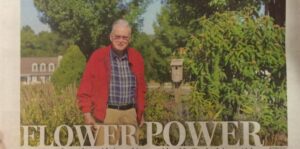
Summit resident takes pride in making outside of facility look beautiful
Tooling slowly around the grounds of The Summit retirement community in a golf cart with his wife Liz, Bill Hodges points to Forsythias, Hydrangeas, Mexican Sunflowers, Day Lilies and Hostas. It’s when he rolls up beside a long row of now dormant Echinacea, that his wife Liz swoons. Of the 17 small gardens he’s created at The Summit, this is her favorite.
He smiles and nods as she talks about how vibrant the area becomes when the Echinacea, or cone flowers, come to full bloom. Gardening “has been a great outlet for us since we moved here,” says Liz, an author who moved with her husband, Bill, to The Summit retirement community from Forest 11 years ago. “I want to make this place pretty, and I want (the people that live here) to like it,” Hodges, a Master Gardener, said one Wednesday morning, as he provided a tour of the fruit-tree-filled orchard and more than a dozen flower-filled gardens residents rave about.
“He tends our flower beds, planting flowers and shrubs that we enjoy year round. He has developed a small orchard with peach, pear, and apple trees as well as various berry bushes. As he’s aged, I’ve seen him many times lying on the ground pulling weeds,” The Summit resident George Harrison said.
Formerly a member of the Jefferson Choral Society and the Lynchburg Fine Arts Center Chorus, Bill also leads a small choir at The Summit with monthly sing-along for residents. “He still has an excellent voice, and we often enjoy hearing him sing,” Harrison said.
For many years, Bill was active with the Kiwanis Club, restoring a steam engine and caboose in Riverside Park and building playgrounds and a bateaux for the Batteaus Festival, but today, it’s the Master Gardener in him that gets the most attention.
“I’ve worked hard trying to figure out a blooming cycle so you have something blooming at all times,” Hodges said. A tour of his work begins at his own back door, where Sedum, Dianthus, purple Aster, black-eyed Susan and Nandina embrace the house. Nestled in a small nook behind the garage, a flox garden is home to a Blueberry bush that produced several pints of berries in the summer, lavender Asters and the Ajuga groundcover that Hodges has become smitten with.
Nearby, pots of strawberry plants are being prepared for the winter, and nearly a dozen tiny lavender seedlings away their fate. Not far away is the first resident-planted garden in The Summit, a butterfly garden thick with butterfly bush and butterfly weed. Hodges now maintains that garden and has added more than a dozen others to any unadorned corner of the property. He is part of a committee composed of Summit residents who help select plants and has created a special fund to cover the cost of new plants they want to put in.
Walking past Coleous, Toad Lilies, Goldenrod, Mallow and Joe-Pye weed, Hodges explains a person has to love gardening in order to be successful. “If you like plants, you have to think like a plant, you have to figure out what they like. Try to put it where it will do some good,” he said. “You have to be willing to spend some time on it” and be willing to pull the darn weeds, he said.
Liz explains while the gardens are beautiful in the spring, Bill has arranged it so they are never without color. Just in time for the holiday season, and when most gardens are dormant, their garden shrubs send forth bright red berries.
The Hodges have found it’s not just the gardens that stop people in their tracks but also the gardener who curates them. “He does cause a bit of a sensation when he’s out working in the garden,” Liz said. Because of his chronic back pain, Bill regularly lies down to garden. Passersby often think he’s fallen, or worse, and call Liz to tell her something has happened to Bill. She appreciates the concern and always gets a good laugh out of it. “I have a good time with them,” Bill said. “They come up and say, ‘Are you all right’ and I say ‘yeah, how about you?’”
Amy Trent writes for The News and Advance. Contact her at [email protected] or 434.385.5543.
November 2, 2015
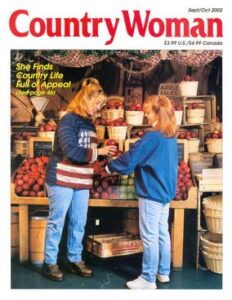
Arts and crafts have been part of Maryann Nance Birdsell’s life ever since childhood. Many relatives in her immediate family are artists and she has examples of their works in her apartment. Several of Maryann’s paintings hang in the Summit hallways.
After Maryann’s last child was off to college, she wanted to paint again and decided to put together a small working area. She found a sturdy table to use, set up her easel, and spread out her painting supplies. Within a short time, a bank in Shreveport, Louisiana sponsored her in several one-man shows.
Maryann’s sister lived in Lake Placid, Florida and she stayed with her sister to do annual art shows. A great many of her pieces sold at these shows, and she gained wide publicity as an artist. She was thrilled when a bank in Florida sponsored her each year for a one-man show.
When her husband passed away, a granddaughter, Heather, moved in with her. They traveled together and enjoyed each other’s lives. When Heather was in high school, they moved to Houston, Texas to be near Maryann’s son Larry and family. In Houston, she was active with painting and took part in many art shows.
After Heather was out of college and married, Maryann moved to Hickory, North Carolina where she moved into a cottage on her daughter’s farm. The cottage turned out to be a roomy house. Maryann found it to be the perfect, peaceful home to pursue her painting and crafts. She added a small building near her studio to be her workshop and storage area. Her grandchildren always referred to her handmade gifts as, “Grandma’s Treasures,” so that became the name of her business.
Maryann’s crafting also included such as wicker ware decorating, silk flower arranging, and wood working. Little did she know that the next time she visited relatives in Indiana, she would add a new craft to her repertoire. She saw a display of painted gourds but felt they were ugly. She knew she wanted to try working with them. She found a person who would sell her three unpainted gourds. As she left, her head was swimming with ideas to paint them. She was so excited.
She cleaned the gourds, and sanded them. She drilled a hole in each one to make birdhouses. She painted one that had a long tail to look like a cat. The other two were painted with flowers and birds. She had just finished painting them when a friend stopped by and bought them. Maryann discovered that painting gourds could turn into a profitable business. Her most memorable sale came when a lady called who had come into town to buy furniture and wanted to see her gourds at the same time. The lady had her two sisters with her. They had never seen such gourds before. They ended up doing their Christmas shopping and spent $760.
Maryann became a regular customer of farmers in the area who grew gourds. Her grandchildren helped wash and scrape the ones that were not clean. She continued to get orders for birdhouses and Santa Clauses of every occupation. One special one was a small gourd which she painted to look like a frog. She called them Carolina Croakers and they sold as souvenirs through a gift shop in Hilton Head. In no time she was supplying gourds to 15 outlets in Indiana, Tennessee, Georgia, South Carolina, Maryland, and North Carolina
In September of 2002, she was contacted by Country Woman Magazine. The editor was able to include her name and address. Following that, Maryann received letters from every state except Hawaii and every province in Canada. She received over 1500 letters and was still getting some after moving to the Summit in 2005.
Maryann continued her gourd work for another year but due to a medical eye condition, she decided to retire from handling gourds. She donated the gourds and some of the tools and paints to the Hickory Museum of Art. Now, at the Summit, she paints whenever she has the time.
By Hazel Harrison
October 16, 2015
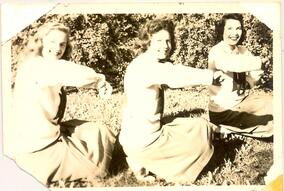
The Cheerleading Squad at E. C. Glass High School always selected new cheerleaders as members graduated from the school. When Mary Lucy Marshall (White) was elected as a junior, the girl cheerleading next to her was Gloria Layne (Farrar). With several practices a week and numerous trips to sport’s games, they became best buddies. Since Gloria was one year ahead of Mary Lucy, Gloria graduated first and that year, her brother, Bobby was selected as a new cheerleader. He held the position next to Mary Lucy and they also became best friends.
Gloria moved on to enter Lynchburg College and Mary Lucy followed right behind her the next year. Although their cheerleading days were over, the two again met on the field hockey team. Gloria was a “wing” and Mary Lucy was a “halfback.” The team played Longwood, Madison, and several other schools in the state. In fact, Gloria was the high scorer in one game against Bridgewater. They entertained themselves with singing during bus rides to games.
Mary Lucy and Gloria, along with several other girlfriends, were often asked to model clothes, shoes, and accessories for the major department stores such as Guggenheimer, J. C. Penny, and Miller and Rhodes. Many times, they modeled evening wear or swim suits. On one occasion, they were modeling for the Women’s Club on Court Street and Gloria remembers singing “I’m Going to Wash that Man Right Out of My Hair” while wearing pajamas! Gloria graduated with a BA in Religion and moved on to Indianapolis to work for the Foreign Division of the Disciples of Christ Church Headquarters.
Gloria’s husband passed away in1996. In 1997, Pres Farrar’s wife passed away. Gloria sent him a sympathy card and it was the first time Pres knew that she had returned to Virginia from New York. Pres contacted Gloria and asked her to attend the dedication of B & W’s Critical Lab as a national historic site. Both had previously worked there. The rest is history. They were married in 1999 and bought a house in Forest. However, 13 years later, they moved to the Summit and now live in a small cottage by the lake.
Through mutual friends, word spread quickly that Pres and Gloria were moving to the Summit. Mary Lucy was excited to hear that two of her best friends would be joining her at the Summit. Four decades after cheerleading together at E. C. Glass and playing field hockey together, Mary Lucy White and Gloria Farrar are together again. Their laughter can often be heard in the dining room as they recall so many funny incidents of their lives together and apart.
By Hazel Harrison
October 1, 2015
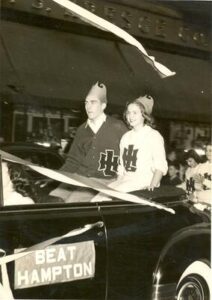
A Happy Life
During the 1930s, small Virginia towns were relatively free of crime and safe for children to play in their yards and on the streets. This was certainly true of South Boston when Mary Lucy, a Summit resident, moved there with her parents. Her father worked for ESSO Standard Oil and Mary Lucy was excited to live in the big city. She immediately strapped on her roller skates and hit the sidewalks.
By junior high age, Mary Lucy attended Robert E. Lee Junior High on 12th street in Lynchburg and she entered E. C. Glass High School as a freshman. In E. C. Glass, Mary Lucy was elected to join the very popular cheerleading squad. This group opened up many opportunities to her as she became friends with a large group of girls who traveled with the football team to all games.
In her senior year, the class elected Mary Lucy their Senior Queen and Bill Lea, Senior King.
Bill was a popular football player and went on to play football at Duke University. He later was Dr. Lea, a practicing Lynchburg dentist who is now retired.
During her senior year, several of her friends entered the Miss Lynchburg Contest and convinced Mary Lucy to also enter the contest. She wore a new bathing suit and platform, high heels as #14 who walked across the stage. She became the First-Runner-up and her best friend won first place.
Mary Lucy graduated from Lynchburg College with a BA in elementary education and psychology. In 1951, she married Pete White, a high school friend with whom she re-connected. Pete had attended Washington and Lee University. Among his sport’s recognitions, he won the Virginia State high hurdle record which still stands in 2015.
Mary Lucy went with Pete to Officer Candidate School, Fort Benning, Georgia. While there, Pete’s class sponsored Mary Lucy in a contest for Queen. Of course she won and what fun they had together! Pete passed away in 2003 and Mary Lucy is now happy in our Independent Living apartments.
The shy little blond on roller skates lived her happy life in Lynchburg as a happy cheerleader, playing college field hockey, and winning beauty contests. All of this extracurricular enjoyment she enjoyed while obtaining her Bachelor and Masters degrees from Lynchburg College. She now delights the Summit residents with her beautiful smile and gregarious personality.
By Hazel Harrison, Resident
Come and see what residents enjoy every day.
Just use the easy quick form or call 434-333-2138 to schedule.

